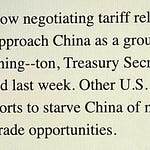There are two recent articles on or near the front page of America's most read Business newspaper, the Wall Street Journal. Both articles clearly show that people writing for the Wall Street Journal have no idea what's going on anymore. Below you can read each article and see what I'm talking about. Above you can listen to me talk about their massive, massive ignorance.
Plug-In Hybrids, Once Shunned, Win Over Buyers in Second Look
Check out some quotes from the above article.
“The plug-in hybrid, long a fringe technology in the car business, is gaining some traction.
As automakers slow-walk plans to roll out more fully electric vehicles in response to lighter-than-expected consumer interest, more are embracing plug-in hybrids, which run on battery power for about 20 to 40 miles before reverting to a gas engine.
The technology has been on the market for more than a decade, but sales hadn’t taken off until recently. Some automakers shied away from offering them because of the added cost and engineering complexity— they essentially require two ways to power the car, packed under one hood. The relatively small number of models available also were pricier than gas-powered cars, limiting their appeal.
Now, car companies are finding more reasons to offer plug-in hybrids, which provide another path beyond full EVs to meet tougher U.S. tailpipepollution rules.”
This is a blatant falsehood. There is nothing “Fringe” about the Technology of a Plug-in Hybrid. It has both a battery and switches to gasoline when the battery runs out. Not Fringe. It is not as the definition of “fringe” used as an adjective is “peripheral, or extreme.”
The first sentence of this article that I am quoting should be changed to something like "Plug – in hybrids, Long desired by the majority of car driving americans, are finally being built by the sycophant leaders of major USA car companies as their disastrous bet on electric cars that do not have the range that American car drivers want has cost their shareholders multiples of billions of dollars.”
There could be other headlines, they would go like this: “Disastrous leader of Hertz rental car has been fired—why is the CEO of Ford Motor company still there?”
The Article goes on:
“Ford Motor said this past
week that it canceled plans for a fully electric large SUV and instead will offer hybrid versions, potentially including plug-ins.
The number of plug-in-hybrid models on sale in the U.S. has nearly doubled since 2019, to 47, according to automotive- research site Edmunds. These include well-known nameplates, such as the Toyota RAV4 and Ford Escape compact SUVs.
Dealers said some car shoppers who are interested in going electric still want the security of a gas engine.”
Are you noticing in the article that the billions of dollars that has already cost Ford Motor Company to build fully electric cars combined with the cancellation of trying to build a Ford expedition of course billions more is not in the article!
How about the last sentence above. Do you think it is “some car shoppers” or the “vast majority of car shoppers” who want not necessarily “the security of a gas engine.” But rather “the security of at least 500 miles of driving before they have to fill up and then when they fill up they can do so conveniently and quickly just about any place within 3 miles of where they are” (quote from me, steve laffey)
So let’s move to the next Artcle.
What Americans Get Wrong About Electric Cars
Charging isn’t the headache that many people think it is. For many, the outlet that’s already in their garage is almost always all they’ll need to keep an EV running.
I attach some of his ignorant statements. But to sum up, this person not only quotes the head of Ford motor Company as if he's the right person to quote (remember, Mr. Farley, has been paid over $10 million per year to destroy shareholder equity by moving into Electric cars that that lose over $50,000 per vehicle when they're built and billions of dollars per year now that he's canceling factories that he was previously going to build. Billions of dollars of losses after being paid millions of dollars, wouldn't you love a job like that?) But the big point this guy makes is that the little guy, the middle-class person, is just a person who only takes for extra trips a year when he or she would need a regular car. First, what is this person supposed to do? Not take those trips? Don't visit their grandmother, or mom, or relatives for Christmas? Don't drive to Vermont for a ski trip? Rent from Hertz electric car by mistake and run out of fuel? Or simply look for charging stations along the way in Chicago in the winter and get in line and freeze to death?
His supposition is that people can simply drive 40 miles per day or less and get their charging down to 60% or so and charge overnight with 120 volts and be fine is preposterous. Anybody reading this would know that that is not ok, that things come up in life that require you to get somewhere quick and it's a long way away and you can't stop and look for a charging station. This is like an article out of the Soviet Union—pure propaganda and yet there is in the Wall Street Journal!
“But then I opted to test a Kia EV9 for a week. This required charging a vehicle with a nearly 100 kilowatt-hour battery—twice the size of a base Tesla Model 3—from a conventional home outdoor outlet that usually isn’t handling anything more intense than a string of Christmas lights. The surprise was that—for seven days of errands, pickups, and even a lengthy road trip—being limited to charging at the slowest possible rate was just fine, and my inability to fast charge away from home was a nonissue.”
“Short distances? No problem
The average American travels more than 40 miles a day, according to one estimate, but that varies a great deal, with many commuters driving less, and a smaller number driving far more. Based on conversations with experts on EV adoption and range, my experience isn’t atypical.
Put simply: the driving patterns of most Americans mean that most of us will rarely exceed the range of today’s modern, longer-range electric vehicles. As Ford CEO Jim Farley—a self-confessed “petrolhead” now making EVs—recently wrote: “our research shows that roughly half of Americans take trips over 150 miles only four days or fewer per year.”
“For my experiment, I parked the Kia in the driveway alongside my house and attached the charging cord that came with the vehicle to a standard extension cord that reached the outdoor outlet by my front door. When I first plugged in after a long day trip, during which I almost completely discharged the battery, the vehicle helpfully informed me that it would only take 70 hours to fully recharge at the paltry rate my standard 120-volt outlet could handle. This seemed like a disaster, but as the week unfolded, it was anything but.
As it turns out, charging the vehicle overnight added more than 15% capacity, or about 40 miles of range, more than twice what I needed for the subsequent day’s errands. The accumulated surplus charging over the course of the week of daily driving meant that by the end the vehicle was nearly 70% charged.
Keep in mind that if I had hooked the vehicle up to a home level 2 charger it would charge six times as fast. That would mean I could go from empty to 100% overnight.”
You could, but as millions of drivers have said, and I said would happen, they don’t want to.
There she is! Toughest lady in America.












